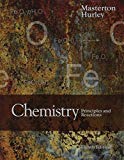
Bundle: Chemistry: Principles and Reactions, 8th, Loose-Leaf + OWLv2, 1 term (6 months) Printed Access Card
8th Edition
ISBN: 9781305717497
Author: William L. Masterton, Cecile N. Hurley
Publisher: Cengage Learning
expand_more
expand_more
format_list_bulleted
Question
Chapter 23, Problem 9QAP
Interpretation Introduction
Interpretation:
The portion of polymer chain obtained from the monomers ethylene glycol and oxalic acid needs to be sketched.
Concept introduction:
A polymer is a long chain consists of large number of monomer units. In a polymer, the monomers are linked to each other in a continuous or repetitive manner. These monomer units are linked to each other either through the formation of peptide linkage, glycosidic linkage or by removal of any moiety such as a water molecule. Polyvinyl chloride, Bakelite and polystyrene are some of the examples of
Expert Solution & Answer
Trending nowThis is a popular solution!

Students have asked these similar questions
Consider a solution of 0.00304 moles of 4-nitrobenzoic acid (pKa = 3.442) dissolved in 25 mL water and titrated with 0.0991 M NaOH. Calculate the pH at the equivalence point
What is the name of the following compound?
SiMe3
K
Draw the starting structure that would lead to the major
product shown under the provided conditions.
Drawing
1. NaNH2
2. PhCH2Br
4 57°F
Sunny
Q Search
Chapter 23 Solutions
Bundle: Chemistry: Principles and Reactions, 8th, Loose-Leaf + OWLv2, 1 term (6 months) Printed Access Card
Ch. 23 - Prob. 1QAPCh. 23 - Prob. 2QAPCh. 23 - Prob. 3QAPCh. 23 - Prob. 4QAPCh. 23 - Prob. 5QAPCh. 23 - Prob. 6QAPCh. 23 - Prob. 7QAPCh. 23 - Prob. 8QAPCh. 23 - Prob. 9QAPCh. 23 - Prob. 10QAP
Ch. 23 - Prob. 11QAPCh. 23 - Prob. 12QAPCh. 23 - Prob. 13QAPCh. 23 - Prob. 14QAPCh. 23 - Prob. 15QAPCh. 23 - Prob. 16QAPCh. 23 - Prob. 17QAPCh. 23 - Prob. 18QAPCh. 23 - Prob. 19QAPCh. 23 - Prob. 20QAPCh. 23 - How many chiral carbon atoms are there in ...Ch. 23 - How many chiral carbon atoms are there in sucrose?...Ch. 23 - Prob. 23QAPCh. 23 - Give the structural formulas of two different...Ch. 23 - (a) How many tripeptides can be made from glycine,...Ch. 23 - Prob. 26QAPCh. 23 - Prob. 27QAPCh. 23 - Prob. 28QAPCh. 23 - For alanine, Ka1=5.1105,Ka2=1.81010 . Calculate...Ch. 23 - Prob. 30QAPCh. 23 - On complete hydrolysis, a polypeptide gives two...Ch. 23 - Prob. 32QAPCh. 23 - Prob. 33QAPCh. 23 - Prob. 34QAPCh. 23 - Prob. 35QAPCh. 23 - Prob. 36QAPCh. 23 - Prob. 37QAPCh. 23 - Prob. 38QAPCh. 23 - Prob. 39QAPCh. 23 - Prob. 40QAPCh. 23 - Prob. 41QAPCh. 23 - Sketch the form in which leucine would exist in...Ch. 23 - How many tripeptides could one make from glycine,...Ch. 23 - A 1.00-mg sample of a pure protein yielded on...Ch. 23 - Describe what is meant by (a) the primary...Ch. 23 - Glycolysis is the process by which glucose is...Ch. 23 - Plants synthesize carbohydrates from CO2 and H2O...Ch. 23 - Prob. 48QAPCh. 23 - Prob. 49QAPCh. 23 - Prob. 50QAPCh. 23 - Prob. 51QAPCh. 23 - Aspartic acid acts as a triprotic acid with...
Knowledge Booster
Similar questions
- 7 Draw the starting alkyl bromide that would produce this alkyne under these conditions. F Drawing 1. NaNH2, A 2. H3O+ £ 4 Temps to rise Tomorrow Q Search H2arrow_forward7 Comment on the general features of the predicted (extremely simplified) ¹H- NMR spectrum of lycopene that is provided below. 00 6 57 PPM 3 2 1 0arrow_forwardIndicate the compound formula: dimethyl iodide (propyl) sulfonium.arrow_forward
arrow_back_ios
SEE MORE QUESTIONS
arrow_forward_ios
Recommended textbooks for you
 Chemistry: The Molecular ScienceChemistryISBN:9781285199047Author:John W. Moore, Conrad L. StanitskiPublisher:Cengage Learning
Chemistry: The Molecular ScienceChemistryISBN:9781285199047Author:John W. Moore, Conrad L. StanitskiPublisher:Cengage Learning EBK A SMALL SCALE APPROACH TO ORGANIC LChemistryISBN:9781305446021Author:LampmanPublisher:CENGAGE LEARNING - CONSIGNMENT
EBK A SMALL SCALE APPROACH TO ORGANIC LChemistryISBN:9781305446021Author:LampmanPublisher:CENGAGE LEARNING - CONSIGNMENT World of Chemistry, 3rd editionChemistryISBN:9781133109655Author:Steven S. Zumdahl, Susan L. Zumdahl, Donald J. DeCostePublisher:Brooks / Cole / Cengage Learning
World of Chemistry, 3rd editionChemistryISBN:9781133109655Author:Steven S. Zumdahl, Susan L. Zumdahl, Donald J. DeCostePublisher:Brooks / Cole / Cengage Learning Introductory Chemistry: An Active Learning Approa...ChemistryISBN:9781305079250Author:Mark S. Cracolice, Ed PetersPublisher:Cengage Learning
Introductory Chemistry: An Active Learning Approa...ChemistryISBN:9781305079250Author:Mark S. Cracolice, Ed PetersPublisher:Cengage Learning Principles of Modern ChemistryChemistryISBN:9781305079113Author:David W. Oxtoby, H. Pat Gillis, Laurie J. ButlerPublisher:Cengage Learning
Principles of Modern ChemistryChemistryISBN:9781305079113Author:David W. Oxtoby, H. Pat Gillis, Laurie J. ButlerPublisher:Cengage Learning Chemistry: Principles and PracticeChemistryISBN:9780534420123Author:Daniel L. Reger, Scott R. Goode, David W. Ball, Edward MercerPublisher:Cengage Learning
Chemistry: Principles and PracticeChemistryISBN:9780534420123Author:Daniel L. Reger, Scott R. Goode, David W. Ball, Edward MercerPublisher:Cengage Learning

Chemistry: The Molecular Science
Chemistry
ISBN:9781285199047
Author:John W. Moore, Conrad L. Stanitski
Publisher:Cengage Learning

EBK A SMALL SCALE APPROACH TO ORGANIC L
Chemistry
ISBN:9781305446021
Author:Lampman
Publisher:CENGAGE LEARNING - CONSIGNMENT

World of Chemistry, 3rd edition
Chemistry
ISBN:9781133109655
Author:Steven S. Zumdahl, Susan L. Zumdahl, Donald J. DeCoste
Publisher:Brooks / Cole / Cengage Learning

Introductory Chemistry: An Active Learning Approa...
Chemistry
ISBN:9781305079250
Author:Mark S. Cracolice, Ed Peters
Publisher:Cengage Learning

Principles of Modern Chemistry
Chemistry
ISBN:9781305079113
Author:David W. Oxtoby, H. Pat Gillis, Laurie J. Butler
Publisher:Cengage Learning

Chemistry: Principles and Practice
Chemistry
ISBN:9780534420123
Author:Daniel L. Reger, Scott R. Goode, David W. Ball, Edward Mercer
Publisher:Cengage Learning